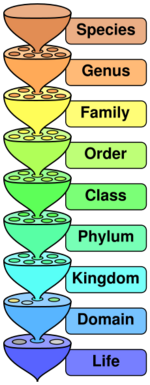Difference between revisions of "Scientific Classification"
m (...) |
DavidKeyes (Talk | contribs) m (pointed out problem with modern-day scientific classification methods based on evolution) |
||
| Line 5: | Line 5: | ||
With advances in knowledge and the discovery of more varied species, the ranks have been further subdivided to allow the precise classification of the relationships of similar species to each other. | With advances in knowledge and the discovery of more varied species, the ranks have been further subdivided to allow the precise classification of the relationships of similar species to each other. | ||
| + | |||
| + | Classic Linnaean taxonomic classification was generally based upon morphological characteristics (i.e. an organism's body shape and internal structure); however, biologists now attempt to classify organisms based on similarities in genetic structure, the underlying assumption being that Darwinism is the cause of speciation. Since the theory of evolution is disputed and unverifiable, many creation scientists favor returning to the traditional Linnaean classification system. | ||
Revision as of 20:07, December 13, 2009
Scientific Classification is the method by which biologists group and categorize species of organisms. All species of life are classified in a ranked hierarchy, starting with Domains, which are then divided into Kingdoms. Kingdoms are divided into Phyla (singular: phylum), which are further divided into Classes, and they, in turn, into Orders, Families, Genera (singular: genus), and Species. The ranks below species are, in zoology, Subspecies and Morph, and in botany, Variety (varietas) and Form (forma).
With advances in knowledge and the discovery of more varied species, the ranks have been further subdivided to allow the precise classification of the relationships of similar species to each other.
Classic Linnaean taxonomic classification was generally based upon morphological characteristics (i.e. an organism's body shape and internal structure); however, biologists now attempt to classify organisms based on similarities in genetic structure, the underlying assumption being that Darwinism is the cause of speciation. Since the theory of evolution is disputed and unverifiable, many creation scientists favor returning to the traditional Linnaean classification system.
